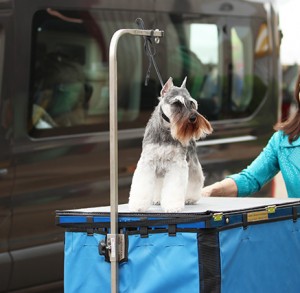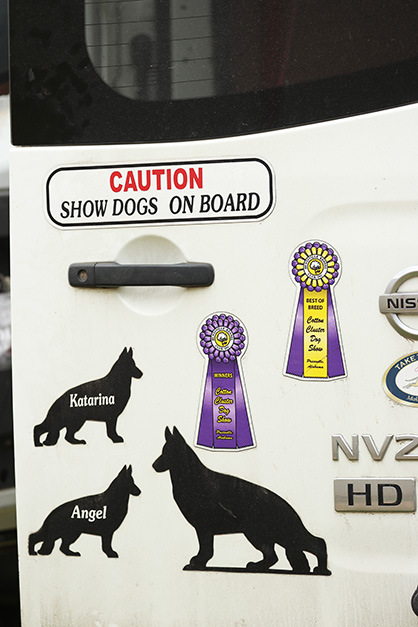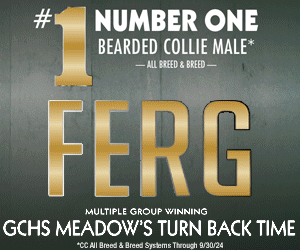Why a Dog Show is NOTHING and EVERYTHING Like a Horse Show
By: Brittany Bevis
You might think that after 18 years of showing horses, some 10 equine partners, 5 World titles, 5 Reserve, and a #1 Top 20 Youth title that I might know a little something about competing with animals. Showing a dog has to be like showing a horse, right? Wrong. Very wrong.
In addition to showing horses for almost the past two decades, I’ve been training my dog in agility for the past three years. It was always just a fun hobby- a way to release excess Australian Shepherd/Golden Retriever/Lab/Border Collie energy. (Quite a mix, I know). But, I’d never considered actually competing. When you show horses, there’s no time for anything else. However, having found myself recently unhorsed, my trainer suggested I try a local competition. My dog has always been great in practice. How hard could it be?
Remember that feeling you had when you went to your very first horse show? You had no idea where the entry booth was or even how to enter, for that matter. The elaborate stall set ups made your rolling saddle rack and bucket full of supplies pale in comparison. It seemed like everyone knew exactly what was going on and what they were doing, except for you. I had a similar feeling when I decided to enter my first AKC agility trial. I was a fish out of water, or a horse out of pasture, as it were.
What’s agility, you ask? Agility is a sport wherein a dog and handler navigate a course of obstacles like jumps, a pause table, seesaw, tire, A-frame, dog walk, and weave poles. Agility is judged on time and faults, much like a Jumping course. It’s basically the equivalent of turning your horse loose on a Trail course and relying solely on hand signals and voice cues for navigation. Try that at the next horse show, and let me know how it works out for you.
That makes what these intelligent dogs are able to do all the more incredible. Ever seen a Cutting horse crouch down on its hocks as it darts back and forth attempting to cut a cow from the herd? That’s the same feeling you get while watching a lighting-fast Border Collie race through a course responding to imperceptible cues from its handler. There’s definitely something to be said for specialized breeding.
Tricky Training
Given the obvious similarities between a Trail course and an Agility course, I assumed I’d have an advantage. Wrong again. Early on in our training, I had to learn how to stop crowding my dog. My trainer kept telling me that it was like I was trying to run the course in my dog’s place, and I was getting in her way. When you’ve ridden on top of an animal through a course, instead of running alongside one, it’s hard to make your brain adjust.
An agility obstacle that looks very similar to something you may have seen at a horse show is the weave poles. A set of weave poles mirrors a Western Riding line or Pole Bending pattern. It even looks similar. Like teaching a horse how to change leads, teaching a dog how to weave poles looks super cool and takes a very long time to master.
After weekly training sessions to master our skills, my pup, Ellie Mae, and I were ready to compete. But, just like in AQHA or APHA competition, a dog isn’t eligible to compete in AKC unless it has been registered. Luckily, thanks to the AKC Canine Partners program, it isn’t necessary for your dog to be a purebred. Good news for my Shepherd-Retriever-Lab-Collie! But, much like what happens to almost every horse breeder around foaling time, my pup’s name was already taken. The computer program suggested a few alternatives by using my address for inspiration. Thus, I’m now the proud owner of Ellie Mae of Dancing Shadows… not any weirder than some of the horse names I’ve heard before.
Learning the Lingo
With registration certificate in hand, and my pup’s leash in the other, I headed off to the entry booth. Figuring out the schedule reminded me of the same confusion that set in when I looked at a showbill for the first time. Are we Novice, Masters/Excellent, or Open? What’s the difference between Standard and JWW? And then came the 94-page rulebook, which resulted in me bombarding my trainer with 100 questions.
Me: ”No treats or toys on the course. Uh, oh.”
Trainer: ”She’ll be fine.”
Me: ”No intentional contact with the dog. Does that begin after I’ve left my dog at the start line, or after my dog crosses the start line?”
Trainer: “All of this will be in the rulebook.”
Me: ”Does the timer start when I start, or do I start when the timer starts?”
Trainer: ”It starts when you start.”
Me: ”What happens if she misses a weave pole? Do we keep going, or go back and try again?”
Trainer: “Really, all of this will be in the rule book.”
Me: ”What if she misses a contact? Do I go back and redo it, or keep going?”
Trainer: …
Me: Hello?
Trainer: …
Just a Dog and its Handler
I had a bag of treats, a toy, water bowl, and snacks for the day. I thought I was pretty well prepared. That was until I pulled into the fairgrounds and saw the miles of motorhomes connected to miniaturized versions of horse trailers. I saw people roll up with giant, tailgating tents, industrial sized fans, crates, folding chairs, coolers, and heat blocking, silver sheet panels to protect their dogs from the sun. One van pulled up and five ginormous Great Danes jumped out of the back. One bonus is that your dog can fit in your car.
But, never fear. If there was something I needed, I could simply pick it up at the trade show that sold everything from collars and treats to services like canine muscular therapy and acupuncture, and then there was the very interesting Canine Semen Bank… And of course there was a show photographer!
Hurry Up and Wait
Just like at a horse show, there was an estimated time sheet listing the number of entries in each class. Now, give me a horse show schedule with three Horsemanship classes and 54 entries to go, and I can predict, down to within 30 minutes, of when I’ll compete. When I tried to calculate how long it would be until my dog and I entered the course, I came up with nine hours… Guess I did that wrong.
Also, just like at a horse show, competitors are given the opportunity to walk the course before the class starts, in order to make a plan of attack. For amused spectators at this particular show, that meant watching 15 grown adults run around in a field giving hand signals to imaginary dogs, while the general public looked on, thinking we’d all gone quite insane.
Something else I learned at this particular show is that, similar to horse shows, despite the crazy weather conditions that may arise, the show must go on. When a freak rainstorm rolled in, I learned that the only reason an agility trial stops is if there is lightning. Good thing I brought a rain jacket.
While I waited for my class, I took a walk around the grounds to check out the other arenas. The other events could be compared to disciplines at a horse show. Conformation is divided into breed, age, and sex divisions and is, for all intents and purposes, a Halter class. Dogs are judged on their conformation and characteristics as they related to the breed standard for breeding purposes.
Fast Cat or Lure Coursing is like Barrel Racing in that both classes are judged on speed, and it’s hilarious, to boot. If someone told me that my dog would be so excited to chase a plastic bag connected to a pulley system running at a high rate of speed across a field, I never would’ve believed them. When I saw the sign for the Fast Cat course, I thought it was, literally, a course for fast cats. I thought we were at a dog show…
And then, there is my favorite. I like agility, because it’s all-inclusive. Happy-go-lucky Golden Retrievers compete alongside spunky Schnauzers and fluffy Bichons. There’s even a designation of All-American for dogs of unknown origin, like mine!
The Ribbons Are Still Blue
Just like at a horse show, the goal is to receive a top placing and points that goes towards a title. I saw a lady who was so excited that she got a “Q.” What on earth is that? Now, a ROM or circuit championship I would know. It turns out that a Q is an abbreviation for a qualifying run. In order to advance into the next division, you need to score three qualifying runs under two different judges, much like running for a year-end award in a breed association.
Just like at a horse show, I was more focused on what might possibly happen with my animal’s performance rather than my own. What would she think of all the spectators? Would she decide to complete ignore me and find the squirrel more interesting? Is she going to jump the fence and run around the fairgrounds terrorizing all of the other dogs? How tall is that fence? Again, I had to rely on the expertise of my trainer, who calmly reassured me that we’d been performing well in practice and that my dog was very tuned in to my cues. She would be fine.
It turned out that none of those things happened. ALL of the errors were handler-caused. Now that’s something all equestrians can relate to.
At the end of the day, Ellie Mae had three out of four qualifying runs in the Novice division. We received one disqualification in the last class for knocking down a bar, but she was fast, responded to my cues, and was very happy to be out on the course doing her thing for the audience. She especially enjoyed all the clapping.
All in all, our first agility trial was a huge success. We will definitely be looking at the calendar to see when the next one is in town. And at only $75 for a weekend, this is a hobby I can actually afford…
Click here to watch Ellie’s debut!
Scroll below to view more fun photos from the dog show.
Short URL: https://caninechronicle.com/?p=142449
Comments are closed





















